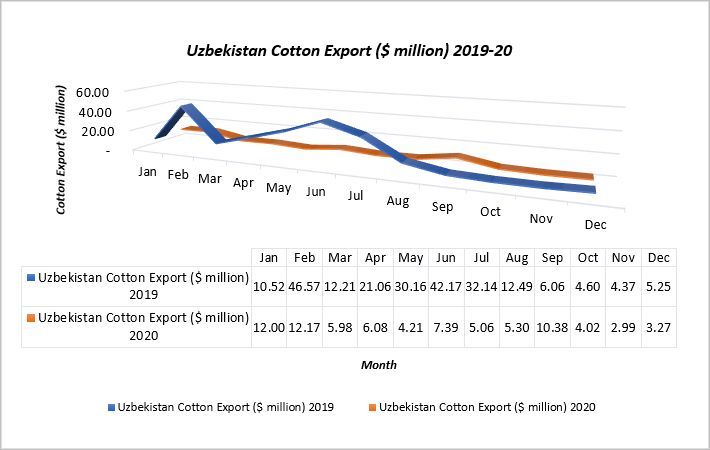Uzbekistan cotton exports plunged 65.35 per cent to $78.87 million in 2020 compared to $227.61 million in 2019. The drop to $5.98 million was first observed in March from $12.00 million in January. The cotton exports remained low throughout the year except September at $10.38 million, according to
Fibre2Fashion's market analysis tool TexPro.
Uzbekistan cotton exports plunged 65.35 per cent to $78.87 million in 2020 compared to $227.61 million in 2019. The drop to $5.98 million was first observed in March from $12.00 million in January. The cotton exports remained low throughout the year except September at $10.38 million, according to Fibre2Fashion's market analysis tool TexPro.#
Uzbekistan planned to ban raw cotton exports to push companies into investing in added value production of finished and semi-finished products such as textiles and fashion. Government funding and support for cotton clusters had encouraged foreign and domestic companies to implement a more fully integrated supply chain.
Uzbekistan cotton exports plunged 65.35 per cent to $78.87 million in 2020 compared to $227.61 million in 2019. The drop to $5.98 million was first observed in March from $12.00 million in January. The cotton exports remained low throughout the year except September at $10.38 million, according to Fibre2Fashion's market analysis tool TexPro.#
Uzbekistan cancelled state regulation of cotton production, price, and mandatory sale from the 2020 harvest season. A decree to this effect was signed by president in March. Cotton producers got the right to choose their zoned varieties, while a certified seed delivery system got maintained. The government cancelled to produce and sell cotton. Setting the purchase price of raw cotton was also cancelled. According to the decree, in regions where there were no cotton clusters, voluntary cooperation of farms was organised with the participation of cotton-ginning enterprises, whose main tasks was to join use of machines, equipment, vehicles and factories by members of the cooperative.
Uzbekistan cotton exports plunged 65.35 per cent to $78.87 million in 2020 compared to $227.61 million in 2019. The drop to $5.98 million was first observed in March from $12.00 million in January. The cotton exports remained low throughout the year except September at $10.38 million, according to Fibre2Fashion's market analysis tool TexPro.#
From March 15, a new credit mechanism for production and processing of raw cotton was introduced. Commercial banks would provide loans for the purchase of raw cotton for up to 12 months for the collection of cotton and the final calculation. The use of concessional loans and the lack of free distribution of funds have led to a 15-20 per cent reduction in cotton production. It was possible to freely use loans and freely choose service companies. The structure of agricultural expenditures was diversified, with an emphasis on areas such as science and seed production.
Uzbekistan cotton exports plunged 65.35 per cent to $78.87 million in 2020 compared to $227.61 million in 2019. The drop to $5.98 million was first observed in March from $12.00 million in January. The cotton exports remained low throughout the year except September at $10.38 million, according to Fibre2Fashion's market analysis tool TexPro.#
The Uzbek government estimated that ending the boycott, which was supported by more than 300 apparel manufacturers and retailers, could let the country earn extra $1 billion in a year alone by selling cotton and textiles on western markets.
Uzbekistan cotton exports plunged 65.35 per cent to $78.87 million in 2020 compared to $227.61 million in 2019. The drop to $5.98 million was first observed in March from $12.00 million in January. The cotton exports remained low throughout the year except September at $10.38 million, according to Fibre2Fashion's market analysis tool TexPro.#
In April 2020, Uzbek government urged to lift the ban on cotton exports of country to fight against the loss due to Covid-19 pandemic, but the cotton campaign said that only complete eradication of forced labour along with civil society reforms such as registering NGOs that monitor worker rights would prompt it to lift the boycott. Many Chinese firms were approaching Uzbekistan as it could provide high quality raw cotton, cheap labour, power that costs 3 cents per kWh.
Uzbekistan cotton exports plunged 65.35 per cent to $78.87 million in 2020 compared to $227.61 million in 2019. The drop to $5.98 million was first observed in March from $12.00 million in January. The cotton exports remained low throughout the year except September at $10.38 million, according to Fibre2Fashion's market analysis tool TexPro.#
In September 2020, Pakistan and Uzbekistan signed a memorandum of understanding (MoU) to set up of a joint working group on trade and economic affairs for promoting economic partnership. The agreement would help both the nations identify areas for trade enhancement, promotion of inter-governmental projects in different sectors and improve connectivity.
Fibre2Fashion News Desk (JL)
